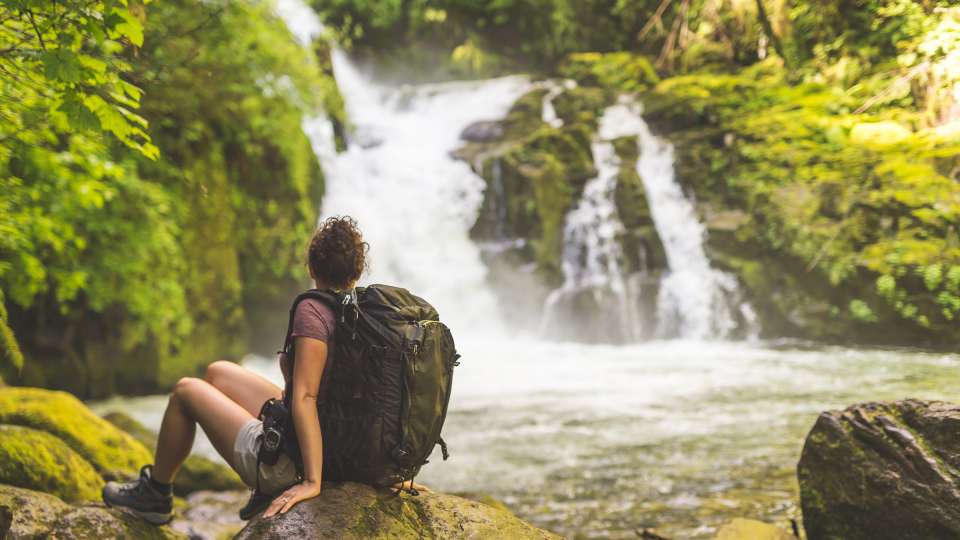
If you’re like many Pacific Northwesterners, you enjoy venturing outdoors. And we’re in a great place for it: This area is brimming with natural beauty to explore.
Before you head over the river and through the woods, wilderness medicine expert Andrew Luks, M.D., has tips for brushing up on your backcountry safety skills. After all, you never know what you’ll find on your journey (hopefully not a wolf dressed like grandma).
Stay hydrated on hot days
Heatstroke is more common in hot weather, especially when it’s humid, but other factors such as age, physical condition, prescription medicines and physical activity level can increase your risk. Look for symptoms like confusion, fever, clammy skin, muscle cramps, nausea and vomiting, headache and rapid heart rate.
Hyperthermia is a medical emergency. If you or someone in your group has these symptoms, seek medical care at once. While you wait for care to arrive, stop physical activity, move into a shady area and remove excess clothing. Make sure the person is staying hydrated and keep them cool by fanning them or applying damp towels.
Prevent hyperthermia by slowing your pace on hot days, taking frequent breaks and staying hydrated.
Prevent hypothermia
Even though the risk of developing a dangerously low body temperature is greatest in cold weather, you can develop hypothermia in above-freezing temperatures as well, especially in wet and windy conditions. Wind can exacerbate slight dampness—like sweating, for example—enough to cause hypothermia. Symptoms include confusion, slow speech, shivering, drowsiness and a weak pulse.
Hypothermia is a medical emergency and medical care should be sought immediately. If you or someone in your group has symptoms, get the person to a sheltered area out of the elements and remove wet clothing. Get them into dry clothes or a sleeping bag. Give them something warm to drink, if possible, and have them eat—metabolism of food generates heat.
Prevent hypothermia by staying hydrated and eating throughout the trip. Also be aware of how many layers you are wearing: If you stop moving for a while, put on extra layers to stay warm.
Make it easy to be found
This makes it much easier for search and rescue teams to find you. If you have a cell phone, try calling for help. If you are within range of a cell tower, rescue teams can often use your phone’s signal to get a rough idea of your location. Because cell phone access is often limited in the wilderness, consider getting a personal locator beacon that can be activated in an emergency and alert search and rescue teams.
Always purify water
Even crystal-clear backcountry streams and lakes can be contaminated with bacteria and parasites that can make you ill. Boiling is the most effective way to purify water; although, when used properly, water filtration devices and water-purification tablets are also highly protective against these organisms.
Use the buddy system
Traveling in a party of four is helpful because, should someone get injured, one person can stay with the injured person while the other two go for help. An injured person should never be left alone.
Share your itinerary
Before you go on a hike, always tell someone where you are going, what route you will take and when you plan to return. Then, if you get lost or injured and do not arrive back at the appointed time, people will know that you may be in trouble and can alert the authorities where to look for you. There are also apps that can help track your whereabouts.
Carry an emergency kit
The Red Cross recommends each hiker carry a survival pack containing items such as extra food, a pocket knife, a map and compass, a whistle, a space blanket, water purification tablets, matches and a candle.
Beware of—but don’t freak out about—bears
If you spot a bear, stay calm. Most likely the bear is not interested in you and will probably leave if you make noise, raise your arms or talk loudly. Don’t run away from the bear—that is prey behavior. Be cautious if you see a cub, as the mother is probably nearby and could become agitated or aggressive if she thinks you are a threat.
Check the forecast
Just because the weather is warm and dry in the city doesn't mean it will be the same in the mountains. Even in summer, weather can vary dramatically at higher altitudes and can change quickly. Check the forecast before you leave and make sure there aren't any weather alerts for the area you're traveling to. It's not a bad idea to bring extra gear in case you encounter mud, rain or even snow.
Editor’s note: This article was originally published Aug. 9, 2017. It has been reviewed and updated with current information.

 Healthy ideas for your inbox
Healthy ideas for your inbox





